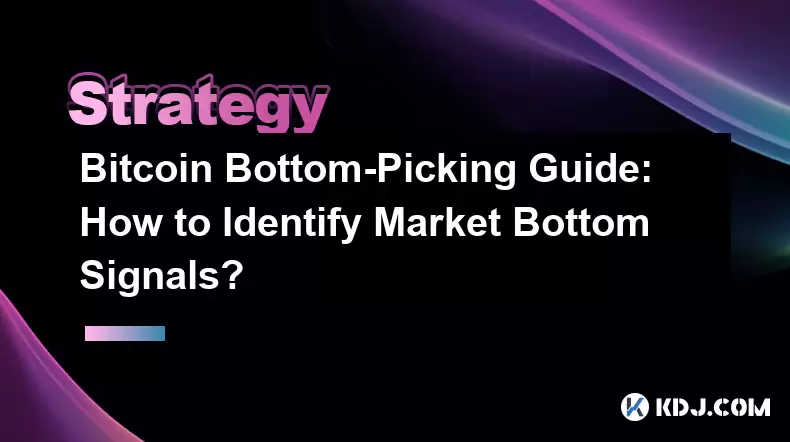-
 bitcoin
bitcoin $122090.672462 USD
1.59% -
 ethereum
ethereum $4493.758974 USD
0.56% -
 xrp
xrp $3.033145 USD
0.65% -
 tether
tether $1.000629 USD
0.00% -
 bnb
bnb $1169.854250 USD
7.07% -
 solana
solana $230.954786 USD
-0.19% -
 usd-coin
usd-coin $0.999785 USD
0.00% -
 dogecoin
dogecoin $0.256108 USD
-1.12% -
 tron
tron $0.342333 USD
-0.12% -
 cardano
cardano $0.859632 USD
-0.10% -
 hyperliquid
hyperliquid $48.932146 USD
-2.25% -
 chainlink
chainlink $22.345466 USD
-1.29% -
 ethena-usde
ethena-usde $1.000217 USD
-0.03% -
 avalanche
avalanche $31.203456 USD
1.93% -
 sui
sui $3.579145 USD
1.05%
Bitcoin Bottom-Picking Guide: How to Identify Market Bottom Signals?
Use technical analysis, sentiment indicators, and on-chain metrics to identify Bitcoin market bottoms, but remember, no method guarantees 100% accuracy.
May 26, 2025 at 08:14 am

Understanding when the Bitcoin market has reached its bottom is crucial for investors looking to maximize their returns. Identifying market bottom signals involves a combination of technical analysis, sentiment analysis, and an understanding of market cycles. This guide will delve into the various methods and indicators that can help you determine when Bitcoin might be at its lowest point, setting the stage for a potential recovery.
Technical Analysis Indicators
Technical analysis is a primary tool used by traders to identify potential market bottoms. Several indicators can signal that Bitcoin may be reaching its lowest point.
Moving Averages: The interaction between short-term and long-term moving averages can provide insights into market trends. When the short-term moving average (e.g., 50-day) crosses above the long-term moving average (e.g., 200-day), it can indicate a potential reversal from a downtrend to an uptrend, signaling a possible market bottom.
Relative Strength Index (RSI): The RSI is a momentum oscillator that measures the speed and change of price movements. An RSI value below 30 typically indicates that Bitcoin is oversold and may be nearing a bottom. Conversely, a value above 70 suggests it is overbought. Watching for the RSI to move out of the oversold territory can be a sign of a potential bottom.
Bollinger Bands: These bands consist of a middle band being a moving average, and two outer bands that are standard deviations away from the middle band. When Bitcoin's price touches or crosses the lower Bollinger Band, it can be an indication that the market is oversold and might be approaching a bottom.
Sentiment Analysis
Sentiment analysis involves gauging the overall mood and attitudes of market participants. Sentiment can often reach extreme levels at market bottoms, providing a contrarian indicator.
News and Media Sentiment: During market bottoms, news and media often report overwhelmingly negative stories about Bitcoin. This pervasive pessimism can signal that sentiment has reached a low point, potentially indicating a market bottom.
Social Media and Forums: Platforms like Twitter, Reddit, and specialized forums can provide real-time insights into market sentiment. A high volume of negative posts and comments about Bitcoin can indicate that sentiment is at a low, which might suggest a bottom is near.
Fear and Greed Index: This index measures the market's emotional state, with readings ranging from 0 (extreme fear) to 100 (extreme greed). A very low reading on the Fear and Greed Index can signal that the market is at a bottom, as fear is at its peak.
Market Cycles and Historical Patterns
Understanding market cycles and historical patterns can provide valuable context for identifying market bottoms.
Cycle Analysis: Bitcoin, like other assets, tends to move in cycles. Recognizing where Bitcoin is in its cycle can help predict when a bottom might occur. Historically, Bitcoin has experienced significant corrections followed by recoveries, and understanding these patterns can aid in bottom identification.
Historical Bottoms: Studying past market bottoms can provide insights into the conditions and indicators that were present at those times. For instance, previous Bitcoin bottoms often coincided with significant negative news events or regulatory actions, coupled with extreme fear in the market.
Volume Analysis: A spike in trading volume at a low price point can indicate that a bottom is forming. High volume suggests that many investors are buying, potentially signaling the start of a recovery.
On-Chain Metrics
On-chain metrics offer a deeper look into the blockchain's activity, which can provide additional signals of a market bottom.
Hash Rate: The hash rate, which measures the total computational power used to mine and process transactions on the Bitcoin network, can indicate network health. A significant drop in the hash rate might suggest miners are selling off their Bitcoin, potentially signaling a bottom. Conversely, a recovery in the hash rate can indicate renewed confidence and a possible bottom.
Transaction Volume: An increase in the number of transactions can signal increased activity and interest in Bitcoin, which might indicate that a bottom is forming. Conversely, a sustained decrease in transaction volume could suggest a prolonged bear market.
Active Addresses: The number of active addresses on the Bitcoin network can provide insights into user engagement. A rise in active addresses might suggest growing interest and a potential bottom, while a decline could indicate waning interest.
Practical Steps for Identifying a Market Bottom
Identifying a market bottom involves more than just understanding indicators; it requires a practical approach to monitoring and analyzing the market.
Monitor Multiple Indicators: Relying on a single indicator can be misleading. Instead, monitor a combination of technical, sentiment, and on-chain metrics to get a more comprehensive view of the market.
Set Alerts: Use trading platforms and tools to set alerts for key indicators, such as RSI levels, moving average crossovers, or significant changes in the Fear and Greed Index. This can help you stay informed and react quickly to potential bottom signals.
Keep a Trading Journal: Document your observations and decisions in a trading journal. This can help you track the effectiveness of different indicators and strategies over time, improving your ability to identify future market bottoms.
Stay Informed: Regularly read market analysis, follow reputable cryptocurrency news sources, and participate in community discussions to stay updated on market sentiment and potential bottom signals.
FAQs
Q: Can market bottoms be predicted with 100% accuracy?A: No, market bottoms cannot be predicted with absolute certainty. While various indicators and methods can provide signals, the cryptocurrency market is highly volatile and influenced by numerous unpredictable factors. Therefore, it's essential to use these tools as part of a broader strategy and to be prepared for potential false signals.
Q: How long does it typically take for Bitcoin to recover from a market bottom?A: The recovery time for Bitcoin after reaching a market bottom can vary significantly. Historical data shows that some recoveries have been relatively quick, taking just a few months, while others have taken years. The duration of recovery depends on various factors, including market sentiment, economic conditions, and regulatory developments.
Q: Are there any specific tools or platforms that can help with bottom-picking?A: Yes, several tools and platforms can assist with bottom-picking. TradingView offers advanced charting and technical analysis tools, while platforms like CoinMetrics and Glassnode provide comprehensive on-chain data. Additionally, sentiment analysis tools like the Fear and Greed Index can help gauge market sentiment. It's important to use a combination of these resources to get a well-rounded view of the market.
Q: How can I differentiate between a short-term dip and a true market bottom?A: Differentiating between a short-term dip and a true market bottom requires careful analysis. A short-term dip is typically characterized by a quick recovery and may not be accompanied by extreme sentiment or significant changes in on-chain metrics. In contrast, a true market bottom often coincides with extreme fear, negative news, and a prolonged period of low prices. Monitoring a combination of technical, sentiment, and on-chain indicators can help you distinguish between the two.
Disclaimer:info@kdj.com
The information provided is not trading advice. kdj.com does not assume any responsibility for any investments made based on the information provided in this article. Cryptocurrencies are highly volatile and it is highly recommended that you invest with caution after thorough research!
If you believe that the content used on this website infringes your copyright, please contact us immediately (info@kdj.com) and we will delete it promptly.
- BlockDAG, DOGE, HYPE Sponsorship: Crypto Trends Shaping 2025
- 2025-10-01 00:25:13
- Deutsche Börse and Circle: A StableCoin Adoption Powerhouse in Europe
- 2025-10-01 00:25:13
- BlockDAG's Presale Buzz: Is It the Crypto to Watch in October 2025?
- 2025-10-01 00:30:13
- Bitcoin, Crypto, and IQ: When Genius Meets Digital Gold?
- 2025-10-01 00:30:13
- Stablecoins, American Innovation, and Wallet Tokens: The Next Frontier
- 2025-10-01 00:35:12
- NBU, Coins, and Crypto in Ukraine: A New Yorker's Take
- 2025-10-01 00:45:14
Related knowledge

Practical parameter settings for a Bitcoin multi-timeframe moving average system
Sep 18,2025 at 10:54pm
Optimizing Timeframe Combinations for Bitcoin Trading1. Selecting appropriate timeframes is crucial when building a multi-timeframe moving average sys...

How can I filter out false breakouts in Dogecoin high-frequency trading?
Sep 22,2025 at 01:00am
Understanding False Breakouts in Dogecoin Trading1. A false breakout occurs when Dogecoin's price appears to move beyond a defined support or resistan...

Techniques for identifying tops and bottoms in the Bitcoin on-chain NVT model
Sep 20,2025 at 07:54pm
Understanding the NVT Model in Bitcoin Analysis1. The Network Value to Transactions (NVT) ratio is often described as the 'P/E ratio' of the cryptocur...

What does the surge in open interest in Bitcoincoin futures mean?
Sep 20,2025 at 11:18pm
Understanding the Surge in Dogecoin Futures Open Interest1. A surge in open interest within Dogecoin futures indicates a growing number of active cont...

How can I use the Ethereum USDT premium to gauge market sentiment?
Sep 18,2025 at 11:55pm
Understanding the Ethereum USDT Premium1. The Ethereum USDT premium refers to the price difference between USDT (Tether) traded on Ethereum-based plat...

What should I do if Ethereum staking yields decline?
Sep 20,2025 at 06:18am
Understanding the Causes Behind Declining Ethereum Staking Yields1. The Ethereum network transitioned to a proof-of-stake consensus mechanism with the...

Practical parameter settings for a Bitcoin multi-timeframe moving average system
Sep 18,2025 at 10:54pm
Optimizing Timeframe Combinations for Bitcoin Trading1. Selecting appropriate timeframes is crucial when building a multi-timeframe moving average sys...

How can I filter out false breakouts in Dogecoin high-frequency trading?
Sep 22,2025 at 01:00am
Understanding False Breakouts in Dogecoin Trading1. A false breakout occurs when Dogecoin's price appears to move beyond a defined support or resistan...

Techniques for identifying tops and bottoms in the Bitcoin on-chain NVT model
Sep 20,2025 at 07:54pm
Understanding the NVT Model in Bitcoin Analysis1. The Network Value to Transactions (NVT) ratio is often described as the 'P/E ratio' of the cryptocur...

What does the surge in open interest in Bitcoincoin futures mean?
Sep 20,2025 at 11:18pm
Understanding the Surge in Dogecoin Futures Open Interest1. A surge in open interest within Dogecoin futures indicates a growing number of active cont...

How can I use the Ethereum USDT premium to gauge market sentiment?
Sep 18,2025 at 11:55pm
Understanding the Ethereum USDT Premium1. The Ethereum USDT premium refers to the price difference between USDT (Tether) traded on Ethereum-based plat...

What should I do if Ethereum staking yields decline?
Sep 20,2025 at 06:18am
Understanding the Causes Behind Declining Ethereum Staking Yields1. The Ethereum network transitioned to a proof-of-stake consensus mechanism with the...
See all articles










































































